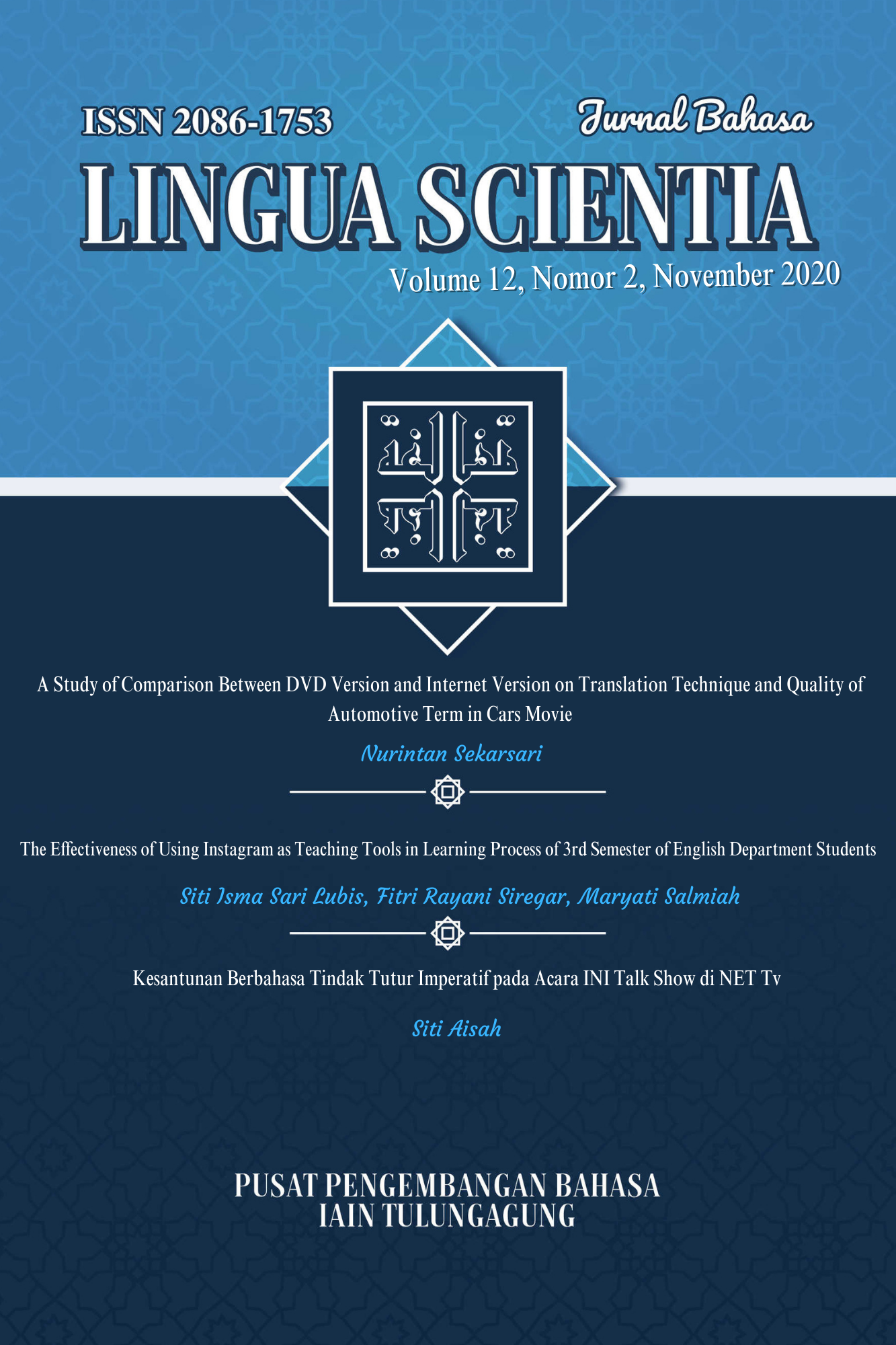Students’ Perceptions on Using E-Learning in EFL Academic Writing Class
Abstract
ABSTRACT
This study aims to describe the students’ perception on using E-learning in Academic Writing. 71 students of English Department fourth semester in academic year 2019/2020 had taken a part in this study. Descriptive quantitative survey research was used with closed-ended form questionnaires as the instrument. The result of this research revealed that the use of E-learning in Academic Writing of English Department students of IAIN Kediri was not new for students. Students’ perceptions on using E-learning in Academic Writing was divided into three categories. The categories are student’s behavior on using E-learning in Academic Writing, students’ perceptions about E-learning operational and students’ perceptions about practicing Academic Writing using E-learning. The result showed positive responses from the respondents. Somehow, they disagree that the use of E-learning in Academic Writing could make them more confident, discipline and enjoy learning. It is because of the internet connection and misunderstanding with the teacher’s instruction. It can be said that E-learning restricted students’ interactions with the lecturer and their classmates. The research finding can be used as the evaluation for English language teaching in general.
Downloads
References
Abbad, M. M., Morris, D., & De Nahlik, C. (2009). Looking under the Bonnet: Factors Affecting Student Adoption of E-Learning Systems in Jordan. The International Review of Research in Open and Distributed Learning, 10(2). https://doi.org/10.19173/irrodl.v10i2.596
Ali, Z. (2015). A Case Study of Tertiary Students " Experiences Using Edmodo in Language Learning. International Journal of Language Education and Applied Linguistics (IJLEAL) Copyright © Penerbit Universiti Malaysia Pahang Print, 2289-9294 Online, 2(2015), 39–48.
Al-Maini, Y. H. (2013). Issues in Integrating Information Technology in Learning and Teaching EFL: The Saudi Experience. The EuroCALL Review, 21(2), 49. https://doi.org/10.4995/eurocall.2013.9790
Alsubaie, J., & Ashuraidah, A. (2017). Exploring Writing Individually and Collaboratively Using Google Docs in EFL Contexts. English Language Teaching, 10(10), 10. https://doi.org/10.5539/elt.v10n10p10
Arkorful, V., & Abaidoo, N. (2014). The role of e-learning, the advantages and disadvantages of its adoption in Higher Education. 2(12), 14.
Benta, D., Bologa, G., & Dzitac, I. (2014). E-learning Platforms in Higher Education. Case Study. Procedia Computer Science, 31. https://cyberleninka.org/article/n/1263783
Biggs, J. (1999). What the Student Does: Teaching for enhanced learning. Higher Education Research & Development, 18(1), 57–75. https://doi.org/10.1080/0729436990180105
Brown, A. R., & Voltz, B. D. (2005). Elements of Effective e-Learning Design | Request PDF. ResearchGate. https://doi.org/10.19173/irrodl.v6i1.217
Brown, C. A., Dickson, R., Humphreys, A.-L., McQuillan, V., & Smears, E. (2007). Promoting academic writing/referencing skills: Outcome of an undergraduate e-learning pilot project. British Journal of Educational Technology, 0(0), 070625111823007-??? https://doi.org/10.1111/j.1467-8535.2007.00735.x
Cai, H. (2012). E-learning and English Teaching. IERI Procedia, 2, 841–846. https://doi.org/10.1016/j.ieri.2012.06.180
Cakrawati, L. M. (2017). STUDENTS’ PERCEPTIONS ON THE USE OF ONLINE LEARNING PLATFORMS IN EFL CLASSROOM. English Language Teaching and Technology Journal (ELT-Tech Journal), 1(1), 22–32.
Chuang, T.-Y., & Su, S.-H. (2012). Using mobile console games for multiple intelligences and education. International Journal of Mobile Learning and Organisation, 6(3–4), 204–217. https://doi.org/10.1504/IJMLO.2012.050047
Clark, R. C., & Mayer, R. E.2003. E-learning and the science of instruction. San Francisco: Jossey-Bass.
Creswell, J. 2013. Qualitative, quantitative, and mixed methods approach Research Design. https://doi.org/10.2307/31521532.
Doculan, J. (2016). E-Learning Readiness Assessment Tool for Philippine Higher Education Institutions | Request PDF. ResearchGate. https://doi.org/10.5121/ijite.2016.5203
Erben, T., Ban, R., & Castaneda, M. (2009). Teaching English language learners through technology. Oxon: Routledge.
Hosseinpour, N., Biria, R., & Rezvani, E. (2019). Promoting Academic Writing Proficiency of Iranian EFL Learners through Blended Learning. Turkish Online Journal of Distance Education, 99–116. https://doi.org/10.17718/tojde.640525
Mason, R.1994. Using Communications Media in Open and Flexible Learning London, Kogan.
McGreal, R., & Elliott, M. (2004). TECHNOLOGIES OF ONLINE LEARNING (E-LEARNING).
Nguyen, T.2015.The Effectiveness of Online Learning: Beyond No SignificantDifference and Future Horizons, MERLOT Journal of Online Learning and Teaching, 11, (2), 309 – 319
Obasa, A. I., Eludire, A. A., & Ajao, T. A. (2013). A comparative study of synchronous and asynchronous e-learning resources. International Journal of Innovative Research in Science, Engineering and Technolog, 2(11), 5938–5946.
Oblinger, D., & Hawkins, B. (2005). The Myth about E-Learning. https://er.educause.edu/articles/2005/1/the-myth-about-elearning
Popovici, A., & Mironov, C. (2015). Students’ Perception on Using eLearning Technologies. Procedia - Social and Behavioral Sciences, 180, 1514–1519. https://doi.org/10.1016/j.sbspro.2015.02.300
Purnawarman, P., Susilawati, S., & Sundayana, W. (2016). The use of Edmodo in teaching writing in a blended learning setting. Indonesian Journal of Applied Linguistics, 5(2), 242–252. https://doi.org/10.17509/ijal.v5i2.1348
Stockwell, G. (2008). Investigating learner preparedness for and usage patterns of mobile learning. ReCALL, 20(3), 253–270. https://doi.org/10.1017/S0958344008000232
Tsiakyroudi, M. (2018). Exploring the effectiveness of Edmodo on Greek EFL B1 learners’ motivation to write. 17.
Wihastyanang, W. D. (2018). THE IMPACT OF ELECTRONIC FEEDBACK ON STUDENTS’ WRITING QUALITY. 8(4), 8.
Wahono, R.S. 2008. Meluruskan Kesalahan Tentang E-learning. http://romisatriawahono.net/2008/01/23/meluruskan-salah-kaprah-tentang-e-learning/ .
World Economic Forum, April 2020, The COVID-19 pandemic has changed education forever. This is how. Accessed on August 2020. www.WEF.com
Yusuf, Q., Yusuf, Y. Q., & Erdiana, N. (2018). ENGAGING WITH EDMODO TO TEACH ENGLISH WRITING OF NARRATIVE TEXTS TO EFL STUDENTS. PROBLEMS OF EDUCATION IN THE 21st CENTURY, 76(3), 333.
Copyright (c) 2020 Ima Fitria

This work is licensed under a Creative Commons Attribution-NonCommercial 4.0 International License.
Before going to review process, all manuscripts will be checked that they are free from plagiarism practice using "Turnitin" software. If there is an indication of plagiarism, the manuscript will instantly be rejected.


